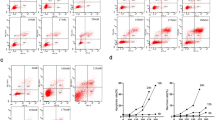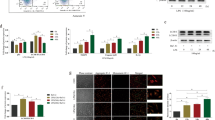Summary
In order to investigate the apoptotic pathway of rabbit annulus fibrosus (AF) cells induced by mechanical overload, an experimental air-pressure model was established in this study to pressurize the rabbit AF cells in vitro. Cells were randomly divided into five groups in which the cells were exposed to a continuous pressure of 1.1 MPa for different lengths of time (0, 5, 12, 24 and 36 h). The cell proliferation and apoptosis were detected by cell counting kit-8 (CCK-8) assay and flow cytometry; the alterations in mitochondrial membrane potential were measured by fluorescence microscopy and fluorescence spectrophotometer; the activities of caspase-8 and 9 were determined by spectrophotometry. The results showed that after the cells were subjected to the pressure for 24 or 36 h, the cell proliferation was inhibited; the ratio of cell apoptosis was increased; the mitochondrial membrane potential was decreased; the activity of caspase-9 was enhanced; no activity changes were observed in caspase-8. The results suggested that treatment with a pressure of 1.1 MPa for more than 24 h can lead to the proliferation inhibition and the apoptosis of rabbit AF cells in vitro, and the mitochondrial-dependent pathway is implicated in the pressure-induced AF cell apoptosis.
Similar content being viewed by others
References
Kasra M, Merryman WD, Loveless KN, et al. Frequency response of pig intervertebral disc cells subjected to dynamic hydrostatic pressure. J Orthop Res, 2006,24(10):1967–1973
Ali R, Le MCL, Richardson SM, et al. Connective tissue growth factor expression in human intervertebral disc: implications for angiogenesis in intervertebral disc degeneration. Biotech Histochem, 2008, 83(5):239–245
Hoogendoorn R, Doulabi BZ, Huang CL, et al. Molecular changes in the degenerated goat intervertebral disc. Spine (Phila Pa 1976), 2008, 33(16):1714–1721
Le MCL, Freemont AJ, Hoyland JA. Accelerated cellular senescence in degenerate intervertebral discs: a possible role in the pathogenesis of intervertebral disc degeneration. Arthritis Res Ther, 2007,9(3):R45
Junger S, Gantenbein-Ritter B, Lezuo P, et al. Effect of limited nutrition on in situ intervertebral disc cells under simulated-physiological loading. Spine (Phila Pa 1976), 2009,34(12):1264–1271
Rajasekaran S, Venkatadass K, Naresh BJ, et al. Pharmacological enhancement of disc diffusion and differentiation of healthy, ageing and degenerated discs: Results from in-vivo serial post-contrast MRI studies in 365 human lumbar discs. Eur Spine J, 2008,17(5):626–643
Tschoeke SK, Hellmuth M, Hostmann A, et al. Apoptosis of human intervertebral discs after trauma compares to degenerated discs involving both receptor-mediated and mitochondrial-dependent pathways. J Orthop Res, 2008, 26(7):999–1006
Wei A, Brisby H, Chung SA, et al. Bone morphogenetic protein-7 protects human intervertebral disc cells in vitro from apoptosis. Spine J, 2008,8(3):466–474
Zhao CQ, Jiang LS, Dai LY. Programmed cell death in intervertebral disc degeneration. Apoptosis, 2006,11(12): 2079–2088
Jones P, Gardner L, Menage J, et al. Intervertebral disc cells as competent phagocytes in vitro: implications for cell death in disc degeneration. Arthritis Res Ther, 2008,10(4):R86
Lotz JC, Chin JR. Intervertebral disc cell death is dependent on the magnitude and duration of spinal loading. Spine (Phila Pa 1976), 2000,25(12):1477–1483
Wuertz K, Urban JP, Klasen J, et al. Influence of extracellular osmolarity and mechanical stimulation on gene expression of intervertebral disc cells. J Orthop Res, 2007,25(11):1513–1522
Lee CR, Iatridis JC, Poveda L, et al. In vitro organ culture of the bovine intervertebral disc: effects of vertebral endplate and potential for mechanobiology studies. Spine (Phila Pa 1976), 2006,31(5):515–522
Kasra M, Goel V, Martin J, et al. Effect of dynamic hydrostatic pressure on rabbit intervertebral disc cells. J Orthop Res, 2003,21(4):597–603
Yu WR, Liu T, Fehlings TK, et al. Involvement of mitochondrial signaling pathways in the mechanism of Fas-mediated apoptosis after spinal cord injury. Eur J Neurosci, 2009,29(1): 114–131
Rannou F, Lee TS, Zhou RH, et al. Intervertebral disc degeneration: the role of the mitochondrial pathway in annulus fibrosus cell apoptosis induced by overload. Am J Pathol, 2004,164(3):915–924
Park JB, Park IC, Park SJ, et al. Anti-apoptotic effects of caspase inhibitors on rat intervertebral disc cells. J Bone Joint Surg Am, 2006,88(4):771–779
Ozaki T, Iizuka K, Suzuki M, et al. Threshold-dependent DNA synthesis by pure pressure in human aortic smooth muscle cells: Gialpha-dependent and -independent pathways. Biochem Biophys Res Commun, 1999,256(1): 212–217
Hutton WC, Elmer WA, Boden SD, et al. The effect of hydrostatic pressure on intervertebral disc metabolism. Spine (Phila Pa 1976), 1999,24(15):1507–1515
Kroeber M, Unglaub F, Guehring T, et al. Effects of controlled dynamic disc distraction on degenerated intervertebral discs: an in vivo study on the rabbit lumbar spine model. Spine (Phila Pa 1976), 2005,30(2):181–187
Unglaub F, Guehring T, Omlor G, et al. Controlled distraction as a therapeutic option in moderate degeneration of the intervertebral disc — an in vivo study in the rabbit-spine model. Z Orthop Ihre Grenzgeb, 2006,144(1): 68–73
Liu GZ, Ishihara H, Osada R, et al. Nitric oxide mediates the change of proteoglycan synthesis in the human lumbar intervertebral disc in response to hydrostatic pressure. Spine (Phila Pa 1976), 2001,26(2):134–141
Yu JS, Qiu GX, Yang BL, et al. The difference and its significance of actin in inverterbral disc cells under cyclic hydrostatic pressure in vitro. Chin J Orthopaedics, 2005, (09):52–56
Ariga K, Yonenobu K, Nakase T, et al. Mechanical stress-induced apoptosis of endplate chondrocytes in organ-cultured mouse intervertebral discs: an ex vivo study. Spine (Phila Pa 1976), 2003,28(14):1528–1533
Wilke HJ, Neef P, Caimi M, et al. New in vivo measurements of pressures in the intervertebral disc in daily life. Spine (Phila Pa 1976), 1999,24(8):755–762
Hishikawa K, Oemar BS, Nakaki T. Static pressure regulates connective tissue growth factor expression in human mesangial cells. J Biol Chem, 2001,276(20):16797–16803
Le MCL, Frain J, Fotheringham AP, et al. Human cells derived from degenerate intervertebral discs respond differently to those derived from non-degenerate intervertebral discs following application of dynamic hydrostatic pressure. Biorheology, 2008,45(5):563–575
Scoltock AB, Cidlowski JA. Activation of intrinsic and extrinsic pathways in apoptotic signaling during UV-C-induced death of Jurkat cells: the role of caspase inhibition. Exp Cell Res, 2004,297(1):212–223
Schuler M, Bossy-Wetzel E, Goldstein JC, et al. p53 induces apoptosis by caspase activation through mitochondrial cytochrome C release. J Biol Chem, 2000,275(10): 7337–7342
Mazumder S, Plesca D, Almasan A. Caspase-3 activation is a critical determinant of genotoxic stress-induced apoptosis. Methods Mol Biol, 2008,414:13–21
Rudner J, Lepple-Wienhues A, Budach W, et al. Wild-type, mitochondrial and ER-restricted Bcl-2 inhibit DNA damage-induced apoptosis but do not affect death receptor-induced apoptosis. J Cell Sci, 2001,114(Pt 23): 4161–4172
Andrews HE, Nichols PP, Bates D, et al. Mitochondrial dysfunction plays a key role in progressive axonal loss in multiple sclerosis. Med Hypotheses, 2005,64(4):669–677
van RBJ, Verhoeven AJ, Kuijpers TW. Mitochondria in neutrophil apoptosis. Int J Hematol, 2006,84(3):199–204
Eeva J, Nuutinen U, Ropponen A, et al. Feedback regulation of mitochondria by caspase-9 in the B cell receptor-mediated apoptosis. Scand J Immunol, 2009,70(6): 574–583
Author information
Authors and Affiliations
Corresponding author
Additional information
This project was supported by a grant from National Natural Sciences Foundation of China (No. 30700841).
Rights and permissions
About this article
Cite this article
Xie, M., Yang, S., Win, H.L. et al. Rabbit annulus fibrosus cell apoptosis induced by mechanical overload via a mitochondrial apoptotic pathway. J. Huazhong Univ. Sci. Technol. [Med. Sci.] 30, 379–384 (2010). https://doi.org/10.1007/s11596-010-0361-4
Received:
Published:
Issue Date:
DOI: https://doi.org/10.1007/s11596-010-0361-4




